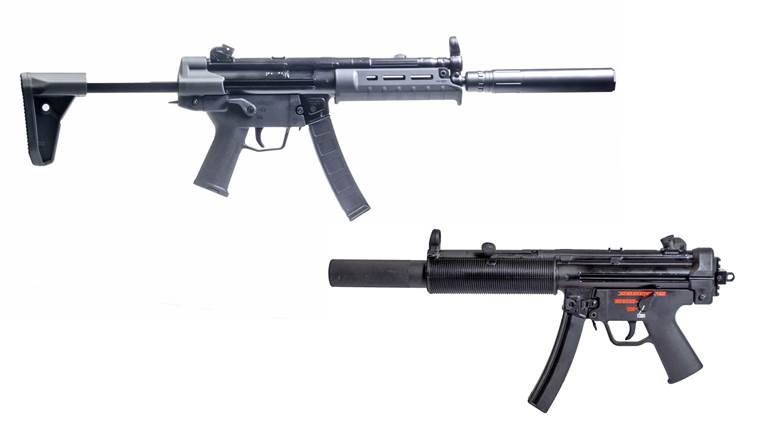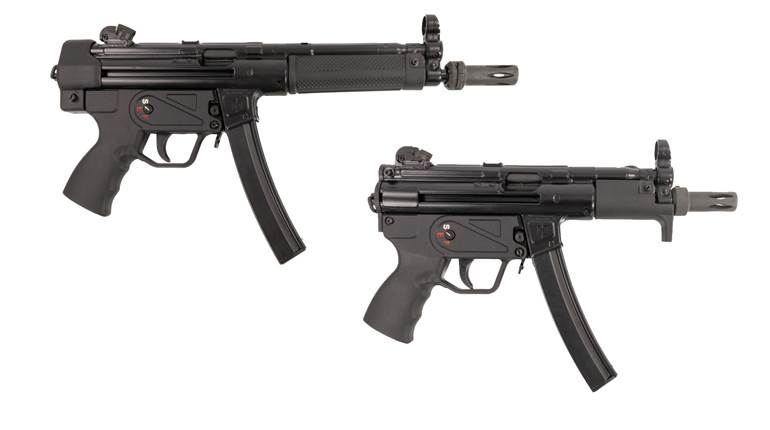
Some call it the Cadillac of submachine guns; others christen it the Rolls Royce of buzz guns. Whatever you call it, there is no doubt the Heckler & Koch MP5 is one of the most highly engineered and sophisticated bullet hoses ever designed. Considering the MP5 is still produced, used and widely coveted today, despite its design being more than 60 years old, it would seem impossible to improve upon. Sure, there have been no fewer than 29 variants of the basic MP5 design, not counting the numerous knock-offs, but at their core all these are based upon technology developed in the 1950s for what was to become the H&K G3 rifle.
Design work for the MP5 started in 1964 with a team of engineers consisting of Helmut Baureuter, Manfred Guhring, Tilo Möller and Georg Seidl. Two years later, the German Federal Police, border guards and special forces added the MP5 to their arsenals. Chambered in 9 mm Luger (9x19 mm) and firing from a closed bolt—a rarity in submachine guns—the MP5 retains many of the features of its parent rifle, including its fluted chamber. The modular trigger group housing contains a hammer, a three- or four-position selector switch and a trigger. The positions are Safe (Sicher) designated by a white bullet crossed out, Semi-Automatic (Einzelfeuer) with a single red bullet, Burst designated by two or three red bullets (if so equipped) and Full Auto (Feuerstoß) with seven red bullets. Early models had the selector switch and designations on the left side of the receiver, but soon this was changed to a fully ambidextrous selector.
 Barrels are cold-hammer forged, ranging in length from 4.5"in the MP5K (Kurz) machine pistol to 8.9" in the full-length MP5. These are pressed and pinned to the receiver, and are free-floating with six grooves in a right-hand twist, 1:10”. The MP5 is air cooled. It is fed from double-column detachable-box magazines with either 15- or 30-round capacities. A tandem clamp is offered as an accessory, allowing two magazines to be held side by side for those really exciting scenarios.
Barrels are cold-hammer forged, ranging in length from 4.5"in the MP5K (Kurz) machine pistol to 8.9" in the full-length MP5. These are pressed and pinned to the receiver, and are free-floating with six grooves in a right-hand twist, 1:10”. The MP5 is air cooled. It is fed from double-column detachable-box magazines with either 15- or 30-round capacities. A tandem clamp is offered as an accessory, allowing two magazines to be held side by side for those really exciting scenarios.
Sights are adjustable, featuring a hood-protected post front sight and a rotating drum diopter rear sight. Rotating the rear sight drum does not regulate the point of impact at different ranges as it does on the rifles. The sight is regulated at the factory for 123-gr. FMJ factory 9x19 ammo to be dead-on at 25 meters. A tool is available that will allow for individual sighting in. The various apertures on the rear sight are for precision—the smaller apertures are used when the gun is needed for tight shots, like in hostage situations.
A cocking handle is located above the barrel about 45 degrees off the top on the left side. It does not reciprocate during firing, and serves only for cocking and as a bolt hold-open device. Weight of the MP5 ranges from 4.3 lbs. for the MP5K to 7.5 lbs. for the MP5SD.
Factory MP5s have a trim, tapered polymer fore-end. Often this is replaced by aftermarket guards featuring Picatinny rails that provide mounting points for laser sights, vertical grips and auxiliary weapon lights.
Operation is identical to the parent, featuring a roller-delayed-lockup blowback bolt mounted in a carrier, which also contains the recoil spring. With the bolt in battery, spring pressure forces the carrier forward against the bolt head. Opposing rollers are internal to the bolt head and in the locked position these rollers are cammed into locking recesses in the rear of the barrel by the carrier. Initial firing forces provide a rearward thrust to the bolt head and carrier assembly, thus keeping them together and locking the breech. As breech pressure decays, the larger mass of the bolt carrier overcomes the spring pressure, allowing it to start moving rearward. After it has moved slightly to the rear, the cams are no longer holding the bolt head in battery. They retract into recesses machined into the carrier, thus allowing the somewhat lower inertia on the bolt head to disengage and move rearward along with the carrier assembly. Some of the rearward inertia is assisted via shallow flutes machined into the chamber that allow a small amount of the combustion gases to break free from the spent cartridge casing. A spring-loaded claw provides extraction while a blade on a pivot mounted in the trigger housing serves as an ejector.
This delayed blowback operation was designed to allow high-intensity rifle cartridges to be safe in a lighter-weight rifle. And while it is fascinating engineering to accomplish similar operation in a pistol-caliber firearm, it really is a little bit of overkill. Even Heckler & Koch went to a much simpler straight-blowback operation with its next generation submachine gun, the UMP. Despite—or perhaps because of—this incredible engineering, the cyclic rate of fire for the MP5 ranges from 700 RPM in the MP5SD, to 800 RPM in the MP5A to 900 RPM in the MP5K. 
HK UMP 45 (Wikipedia image)
The standard MP5A2 has a polymer stock and an 8.9" barrel. It is remarkably controllable and can be used effectively as a precision tool within the limitations of it cartridge. An A3 version is equipped with a collapsible stock, while an A1 has a cap at the butt with a sling swivel for concealment. As 1974 rolled around an MP5SD variant was born, the SD standing for Schalldämpferor “Sound dampener.” This very popular variation has an integral, yet removable, sound suppressor on a 5.9" barrel that has 30 ports 2.5 mm in diameter drilled into it to ensure sub-sonic performance, and therefore quietness. The MP5SD has been a favorite of many special operation units, including Navy SEALS and SWAT teams in a number of metropolitan police departments. 1974 also saw the introduction of the A4 (fixed stock) and A5 (collapsible stock) models with four-position trigger groups—safe, semi-automatic, two- or three-round bursts and full auto. I am told there are those who, in the midst of a gunfight with multiple assailants, have the discipline to switch to burst mode to effectively put two or three rounds into each threat without spraying bullets all around the neighborhood.
Because of its effectiveness and reliability, while undergoing its first compact variant—the A1—the Mp5 received and even more extensive trim job for covert operations like diplomat protection. Christened the MP5K in 1976, this compact machine pistol is concealed as easily as a PDW (personal defense weapon). At just less than 4 1/2 lbs. empty, with an overall length of 12.6" and a 4.53" barrel, the MP5K provides a lot of reliable firepower in a small package.
Another variation sometimes seen is the MP5/10 and MP5/40, which indicate chamberings in 10 mm Auto and .40 S&W, respectively. Introduced in 1992, these were available in fixed- or collapsible-stock variants featuring translucent 30-round magazines. They also have a bolt hold-open feature that retains the bolt in the rear position after the last round is expended from the magazine. Both of these variants were discontinued in 2000.
Semi-automatic-only versions—the HK94 with a 16.54" barrel and either an A2 or A3 stock, as well as SP89 and SP89K pistol versions were made for the U.S. civilian market: briefly even a .22 LR conversion kit was manufactured for the selective-fire guns.
Licensed copies of the MP5 have been made by entities in countries as varied as France, Pakistan, Greece and the United Kingdom, to name a few. Naturally, China has made some unlicensed knock-offs, as well. The H&K MP5 has seen service in literally dozens of countries and extensive use by security and police forces. Its profile is nearly as iconic as the Kalashnikov AK-47.
While the MP5 may be over-engineered, there is little doubt as to its ubiquitous desirability. To remain in production for 53 years and become the world’s most popular submachine gun, even with more modern replacements available, speaks volumes in testament to its robustness and effectiveness.
Additional Reading:
The Keefe Report: Heckler & Koch's MP5K—Operational Briefcase
Video: H&K MP5
To Slap or Not to Slap—Heckler & Koch's MP5






































